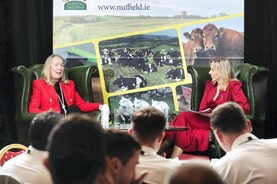Data gathered by agricultural sustainability support and advice programme (ASSAP) advisers on potential water quality issues were discussed in a Teagasc Signpost webinar on Friday 16 July.
ASSAP is a programme where free advice, intended to improve water quality, is provided by Teagasc or dairy co-operative advisers after an individual farm assessment.
The programme’s findings appear to show that farmers are less likely to take corrective action on possible water quality issues when the action recommended by the adviser will have a high investment requirement from the farmer.
Lengthy planning procedures
Lengthy planning procedures and delays in the processing of TAMS applications were also cited as partial reasons to poor uptake among farmers for certain actions.
Most suggested had been acted upon, a point noted by the webinar speakers. However, variations in the rate of action were found.
Up to 95% of low-cost or cost-saving actions recommended by ASSAP advisers were acted upon by the end of 2020, while the corresponding figures quoted for actions associated with higher cost changes were as low as 30% in some instances.
Suggestions
The most costly corrections recommended over the programme suggested that farmers construct additional slurry, effluent and manure storage facilities on farm or that they fence off streams and provide an alternative water source for stock.
The lower-cost - and better followed-up - recommendations related to practices such as changing fertiliser application timings, correcting soil pH and maintaining buffer strips along watercourses.
Fencing waterways
When referencing a list detailing the actions with poorer farmer uptakes, Teagasc ASSAP project manager Noel Meehan referred to the fencing of stock from waterways as one of the areas most in need of an improved effort by farmers.
“It is probably worth noting that there are a couple of actions that are quite high up in the ‘no action’ part - that of stream drinking points and stream fencing,” the programme manager pointed out.
“If there is an issue with livestock in a particular stream, well then we need to put some kind of supports in there for the farmer to have an alternative drinking supply and help the farmer with the cost of that,” he said.
The investment required by farmers was one of the factors hindering actions from being taken
Meehan explained that the issue of funding had been raised with the Department of Agriculture over the course of the scheme, as the investment required by farmers was one of the factors hindering actions from being taken.
Other factors identified to have reduced the uptake of the fencing of waterways included land being rented rather than owned and a poor availability of alternative water sources, Meehan explained in the webinar.
Yard improvements
Issues hindering actions from being taken around slurry storage, silage facilities and yard infrastructure - all potential point sources of nutrients entering waterways - included difficulties in the timely issuing of planning permission.
“There are other issues, let’s say around tanks and concrete works around the yard,” Meehan continued.
“So, I suppose there are grants and there are facilities there and I think what that is indicating is that there it is actually the whole process of getting planning permission, getting TAMS approval and then getting the work done,” he suggested.
The ASSAP programme has been covered by the Irish Farmers Journal in detail in an earlier story, which outlines the initiative aiming to improve water quality with farming practices.






 This is a subscriber-only article
This is a subscriber-only article










SHARING OPTIONS: